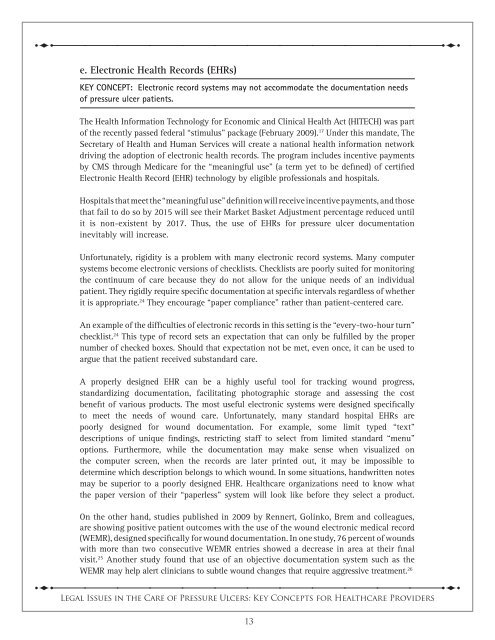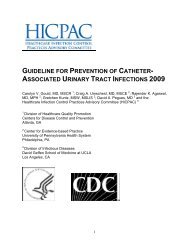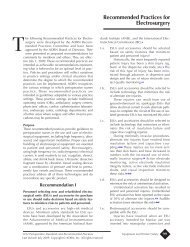Legal Issues in the Care of Pressure Ulcer Patients - Medline
Legal Issues in the Care of Pressure Ulcer Patients - Medline
Legal Issues in the Care of Pressure Ulcer Patients - Medline
Create successful ePaper yourself
Turn your PDF publications into a flip-book with our unique Google optimized e-Paper software.
sttttttttttttse. Electronic Health Records (EHRs)Key Concept: Electronic record systems may not accommodate <strong>the</strong> documentation needs<strong>of</strong> pressure ulcer patients.The Health Information Technology for Economic and Cl<strong>in</strong>ical Health Act (HITECH) was part<strong>of</strong> <strong>the</strong> recently passed federal “stimulus” package (February 2009). 17 Under this mandate, TheSecretary <strong>of</strong> Health and Human Services will create a national health <strong>in</strong>formation networkdriv<strong>in</strong>g <strong>the</strong> adoption <strong>of</strong> electronic health records. The program <strong>in</strong>cludes <strong>in</strong>centive paymentsby CMS through Medicare for <strong>the</strong> “mean<strong>in</strong>gful use” (a term yet to be def<strong>in</strong>ed) <strong>of</strong> certifiedElectronic Health Record (EHR) technology by eligible pr<strong>of</strong>essionals and hospitals.Hospitals that meet <strong>the</strong> “mean<strong>in</strong>gful use” def<strong>in</strong>ition will receive <strong>in</strong>centive payments, and thosethat fail to do so by 2015 will see <strong>the</strong>ir Market Basket Adjustment percentage reduced untilit is non-existent by 2017. Thus, <strong>the</strong> use <strong>of</strong> EHRs for pressure ulcer documentation<strong>in</strong>evitably will <strong>in</strong>crease.Unfortunately, rigidity is a problem with many electronic record systems. Many computersystems become electronic versions <strong>of</strong> checklists. Checklists are poorly suited for monitor<strong>in</strong>g<strong>the</strong> cont<strong>in</strong>uum <strong>of</strong> care because <strong>the</strong>y do not allow for <strong>the</strong> unique needs <strong>of</strong> an <strong>in</strong>dividualpatient. They rigidly require specific documentation at specific <strong>in</strong>tervals regardless <strong>of</strong> whe<strong>the</strong>rit is appropriate. 24 They encourage “paper compliance” ra<strong>the</strong>r than patient-centered care.An example <strong>of</strong> <strong>the</strong> difficulties <strong>of</strong> electronic records <strong>in</strong> this sett<strong>in</strong>g is <strong>the</strong> “every-two-hour turn”checklist. 24 This type <strong>of</strong> record sets an expectation that can only be fulfilled by <strong>the</strong> propernumber <strong>of</strong> checked boxes. Should that expectation not be met, even once, it can be used toargue that <strong>the</strong> patient received substandard care.A properly designed EHR can be a highly useful tool for track<strong>in</strong>g wound progress,standardiz<strong>in</strong>g documentation, facilitat<strong>in</strong>g photographic storage and assess<strong>in</strong>g <strong>the</strong> costbenefit <strong>of</strong> various products. The most useful electronic systems were designed specificallyto meet <strong>the</strong> needs <strong>of</strong> wound care. Unfortunately, many standard hospital EHRs arepoorly designed for wound documentation. For example, some limit typed “text”descriptions <strong>of</strong> unique f<strong>in</strong>d<strong>in</strong>gs, restrict<strong>in</strong>g staff to select from limited standard “menu”options. Fur<strong>the</strong>rmore, while <strong>the</strong> documentation may make sense when visualized on<strong>the</strong> computer screen, when <strong>the</strong> records are later pr<strong>in</strong>ted out, it may be impossible todeterm<strong>in</strong>e which description belongs to which wound. In some situations, handwritten notesmay be superior to a poorly designed EHR. Healthcare organizations need to know what<strong>the</strong> paper version <strong>of</strong> <strong>the</strong>ir “paperless” system will look like before <strong>the</strong>y select a product.On <strong>the</strong> o<strong>the</strong>r hand, studies published <strong>in</strong> 2009 by Rennert, Gol<strong>in</strong>ko, Brem and colleagues,are show<strong>in</strong>g positive patient outcomes with <strong>the</strong> use <strong>of</strong> <strong>the</strong> wound electronic medical record(WEMR), designed specifically for wound documentation. In one study, 76 percent <strong>of</strong> woundswith more than two consecutive WEMR entries showed a decrease <strong>in</strong> area at <strong>the</strong>ir f<strong>in</strong>alvisit. 25 Ano<strong>the</strong>r study found that use <strong>of</strong> an objective documentation system such as <strong>the</strong>WEMR may help alert cl<strong>in</strong>icians to subtle wound changes that require aggressive treatment. 26stttttttttttts<strong>Legal</strong> <strong>Issues</strong> <strong>in</strong> <strong>the</strong> <strong>Care</strong> <strong>of</strong> <strong>Pressure</strong> <strong>Ulcer</strong>s: Key Concepts for Healthcare Providers13
















